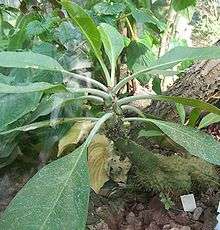Myrmecodia
| Myrmecodia | |
|---|---|
 | |
| Myrmecodia platytyrea | |
| Scientific classification | |
| Kingdom: | Plantae |
| (unranked): | Angiosperms |
| (unranked): | Eudicots |
| (unranked): | Asterids |
| Order: | Gentianales |
| Family: | Rubiaceae |
| Genus: | Myrmecodia Jack |
| Species | |
|
See text | |
| Synonyms | |
Myrmecodia is a genus of epiphytic myrmecophytes (ant plants) native to Southeast Asia and large islands extending south to Queensland in Australia. Myrmecodia plants grow in tree branches and on trunks. In nature, Myrmecodia tubers often grow hanging downward on bare branches without significant amounts of substrate, and thus depend upon symbiosis for most nutriment. The plants store food and water in a greyish brown caudex that swells and grows spines over time. The thick, unbranched stems are covered in clypeoli and alveoli which also grow spines and are densely filled with dry bracts.
From the alveoli emerge small white flowers which can self-pollinate to yield a bright orange, fleshy berry filled with up to six small seeds. Seed dispersal is by birds, that often deposit droppings on the branches and trunks of trees they land on. In this they resemble various parasitic plants such as the mistletoes in families such as Loranthaceae, Santalaceae, and Misodendraceae, but Myrmecodia species are unrelated to the true parasites, being in the coffee- and gardenia family Rubiaceae. Nor are they known to be significantly parasitic themselves, in spite of being epiphytes; their well-developed leaves, plus their adaptations to mutualism with ants, suggest that they use the plants on which they grow mainly for support and to escape from deep shade on the forest floor.
They form a symbiotic relationship with ants[1] and fungi; Philidris cordata (formally Iridomyrmex cordatus) is believed to be the most common ant found occupying Myrmecodia species. [2] Ant plants provide habitats for ant colonies high up into the forest canopy, protecting them from the elements and also predators because of the spines. Hollow, smooth-walled tunnels form within the caudex with external entrance holes, providing an above-ground home for ant colonies. Ants likewise provide defense for the plant and prevent tissue damage. Ant colonies also provide nutrients to the plants by leaving wastes within the tunnels inside the caudex. Special glands lining the tunnels then absorb nutriment for the plant. This symbiosis allows the plants to effectively gather nutrients (via the ants) from a much larger area than the roots ever could cover. It is found that ants are not required for Myrmecodia to form the caudex.[3]
Native people in Vietnam, Indonesia, and Papua New Guinea have been using it for generations to treat many ailments.
Myrmecodia is derived from Greek myrmekodes meaning "ant-like" or "full of ants". It is one of five ant-plant genera in the family Rubiaceae, the others being Anthorrhiza, Hydnophytum, Myrmephytum, and Squamellaria.[4]
Species
The following list of 27 species is based on The Plant List.[5]
- Myrmecodia alata Becc.
- Myrmecodia albertisii Becc.
- Myrmecodia angustifolia Valeton
- Myrmecodia archboldiana Merr. & L.M.Perry
- Myrmecodia aureospina Huxley & Jebb
- Myrmecodia beccarii Hook.f.
- Myrmecodia brassii Merr. & L.M.Perry
- Myrmecodia erinacea Becc.
- Myrmecodia ferox Huxley & Jebb
- Myrmecodia gracilispina Huxley & Jebb
- Myrmecodia horrida Huxley & Jebb
- Myrmecodia jobiensis Becc.
- Myrmecodia kutubuensis Huxley & Jebb
- Myrmecodia lamii Merr. & L.M.Perry
- Myrmecodia longifolia Valeton
- Myrmecodia longissima Valeton
- Myrmecodia melanacantha Huxley & Jebb
- Myrmecodia oblongata Valeton
- Myrmecodia oksapminensis Huxley & Jebb
- Myrmecodia paradoxa Huxley & Jebb
- Myrmecodia pendens Merr. & L.M.Perry
- Myrmecodia platyrea Becc.
- Myrmecodia platytyrea Becc.
- Myrmecodia pteroaspida Huxley & Jebb
- Myrmecodia schlechteri Valeton
- Myrmecodia sterrophylla Merr. & L.M.Perry
- Myrmecodia tuberosa Jack
Note
- ↑ Wilson, Edward O., The Insect Societies, Publisher: Belknap Press 1971, ISBN 978-0-674-45490-3
- ↑ Huxley, Camilla R. (1978-01-01). "The Ant-Plants Myrmecodia and Hydnophytum (rubiaceae), and the Relationships Between Their Morphology, Ant Occupants, Physiology and Ecology". New Phytologist. 80 (1): 231–268. doi:10.1111/j.1469-8137.1978.tb02285.x. ISSN 1469-8137.
- ↑ Huxley, Camilla R. (1978-01-01). "The Ant-Plants Myrmecodia and Hydnophytum (rubiaceae), and the Relationships Between Their Morphology, Ant Occupants, Physiology and Ecology". New Phytologist. 80 (1): 231–268. doi:10.1111/j.1469-8137.1978.tb02285.x. ISSN 1469-8137.
- ↑ Jebb M, Huxley C (8 February 2009). "A revision of the ant-plant genus Hydnophytum (Rubiaceae)". National Botanic Gardens Glasnevin website. Dublin, Ireland: National Botanic Gardens Glasnevin. Retrieved 19 December 2009.
- ↑ Myrmecodia. The Plant List.

Wikimedia Commons has media related to Myrmecodia.